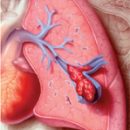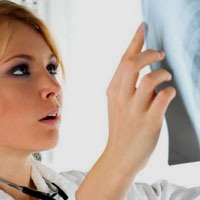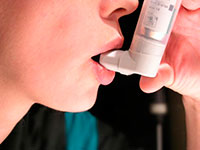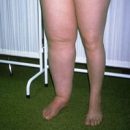What are the symptoms of empya pleura? What are the changes in the leukocyte formula? Answers to these question you will find in the article.
Content
What are the symptoms of empya pleura
A typical answer to any form of suppuration and including the pleural cavity is a purulent-resorbative fever, which is based on the factors of suppuration, resorption - suction of the decay products of the tissue and livelihood of microorganisms, loss factor. The various stages of the course of the disease can nominate one or another symptoms due to the prevailing factor at the moment, be it loss or resorption, and maybe both factors combined. The transition to purulent-resorbative exhaustion occurs, without clear clinical frontiers, sometimes slowed down, sometimes rapidly - for several days, especially with massive gangrene-type grinding processes, exciting light and pleural cavity together.
It is quite clear that the degree of purulent resorbative fever, as well as intoxication, may be different, ranging from light and ending with heavy and hard. Clinical distinction and differential diagnostics are difficult.
 Sometimes a few days after the crisis of pneumonia, since most empiy has the source of them, again there are oznoby, pain in side, shortness of breath, high temperature. It is possible that it is a relapse of lung inflammation. However, soon, after 3-5 days of continuing chills, a distinct dulling of a crushing sound is revealed in the lower half of the chest, more often, on the blade and paravertebral lines. Weakens voice trembling and breathing. In a word, the signs of liquid accumulating in the plevralp. In other cases, the picture is played hidden. It would seem that safely transferred inflammation of the lung does not bring the expected recovery, on the contrary, the shortness of breath, the photo is gradually enhanced, sometimes stabbing pain in the side, temperature rise. Another course of the flow can be the parallel development of pneumonia and purulent exudate in the Polish cavity.
Sometimes a few days after the crisis of pneumonia, since most empiy has the source of them, again there are oznoby, pain in side, shortness of breath, high temperature. It is possible that it is a relapse of lung inflammation. However, soon, after 3-5 days of continuing chills, a distinct dulling of a crushing sound is revealed in the lower half of the chest, more often, on the blade and paravertebral lines. Weakens voice trembling and breathing. In a word, the signs of liquid accumulating in the plevralp. In other cases, the picture is played hidden. It would seem that safely transferred inflammation of the lung does not bring the expected recovery, on the contrary, the shortness of breath, the photo is gradually enhanced, sometimes stabbing pain in the side, temperature rise. Another course of the flow can be the parallel development of pneumonia and purulent exudate in the Polish cavity.
In the clinic, patients fall significantly later. By this time, the symptoms of the suppuration of both the general and local plan are manifest. The face of patients with empieme is characteristic of general inflammation in the body: a light blush, covering cheeks, rather indicates an inflammatory focus, rather than a favorable course of the disease. Some alertness in the gaze, flushing the wings of the nose and the neck muscles involved in the act of breathing completing the appearance of the suffering. Of course, it does not always happen. Small empi - limited, I-II degrees, almost do not affect appearance.
Progressive purulent resorbative fever, Overgoing to exhaustion, regardless of the volume of the empty cavity, but with the concomitant destruction of the pulmonary fabric - «Empiama with destruction of pulmonary fabric» - significantly changes the appearance of the patient. Explosion in the gaze of the Pastoznosti face, spawned cheeks, contouring veins of the neck, the breath of the mouth, dried, slightly lacquered, sometimes a malware smell of mouth believes the picture. In later periods, when the factor of loss appears on the fore, and the symptoms of intoxication are smoothed, the patient looks like a heavy starving.
Dry, pellangroid leather, The pallor of the skin, fingers in the form of drum sticks and nails, as watchcases, are found with great constancy. Bilateral empieve processes or one-sided with the progressive decay of the pulmonary fabric are often manifest with cyanosis, occasionally hemorrhagic diathesis in the form of polymorphic echimosis of the front and side surfaces of the shins, torso. Old doctors were known for a symptom of Bo, testifying to the progressive course of severe illness. The essence of the symptom is the presence of transverse, walking through the entire nail of grooves and strips of appearing from the nail bed and moving to the free edge as the nail grove. It must be said that repeatedly seeing this kind of deformation of the nail records, but without giving himself a report in their essence, we only retrospectively tied this symptom with severe forms of purulent-resorbative exhaustion.
Body temperature - One of the most important signs of purulent resorbative processes. During the initial period and further, in the absence of complete treatment, the temperature reactions can be very significant, passing along the remitting type, in the form of incorrect waves with a trend toward a morning decrease, not achieving, however, normal or even subnormal numbers. When switching to purulent exhaustion, the temperature curve inversion occurs. Morning and evening body temperature ranges from slight limits at the subfebrile level (37.5-38°C) or that prognostically bad, normal numbers with insignificant to semi-degree swing.
Lose weight It comes relatively slowly, primarily due to fatty depots, depleting in the process of intoxication and hyperthermia. As the protein loss, the drop in body weight is enhanced, dissonance is created with due weight.
Swelling of the lower limbs, Sometimes significant, and occasionally and ascites are inherent in extreme, on the verge of exhaustion, the forms of purulent resorbative fever. In these cases, it was possible to observe patients with «dry», «Skeletoe» feet. Significant swelling of the legs is quite part with emphas with destruction of lung fabric. The origin is most likely hypoproteinemic, which in turn is due to hypovolemia. Of course, it is also possible for heart genesis, but rational parenteral nutrition, overlapping losses, leveling of the resorbative factor quite quickly led to the disappearance of edema. The selectivity of localization and permanent parallelism with hypo-and disproteinemia, aggravating the dysfunction of the protein system - water - electrolytes, approved us in the thoughts on the voltage genesis of edema. By I. IN. Davydovsky, edema accompany the purulent-resorbative fever at 8-10%, this percentage increases to 70 with purulent exhaustion.
 Headaches There should always be a matter of thorough research - a full neurological, radiological (skull radiographic radiographs) and electroencephalographic. Twice the cause of headaches was the metastatic brain abscess and both times - in patients with an emphasis of the pleura with the destruction of the pulmonary fabric. Pain in the chest is more often due to changes in parietal pleura, but during the destruction of large pulmonary structures, visceral character acquire. Trying to spare the interested half of the chest, patients occupy a forced position, bending and seeking to provide peace. This selective position often immediately indicates the localization of the process, allowing you to lead a directed steetacoustic search. The intensity of pain is different, but when the cavity has formed, perhaps, never seen so intolerable, burdensome pain that would require the use of analgesics. Empires are more accompanied by pain when breathing, empiemes with the destruction of pulmonary fabric - spontaneous, butying. External type of chest is quite typical. There is an intersecting between intercostal gaps and their narrowing in fibrous thickening.
Headaches There should always be a matter of thorough research - a full neurological, radiological (skull radiographic radiographs) and electroencephalographic. Twice the cause of headaches was the metastatic brain abscess and both times - in patients with an emphasis of the pleura with the destruction of the pulmonary fabric. Pain in the chest is more often due to changes in parietal pleura, but during the destruction of large pulmonary structures, visceral character acquire. Trying to spare the interested half of the chest, patients occupy a forced position, bending and seeking to provide peace. This selective position often immediately indicates the localization of the process, allowing you to lead a directed steetacoustic search. The intensity of pain is different, but when the cavity has formed, perhaps, never seen so intolerable, burdensome pain that would require the use of analgesics. Empires are more accompanied by pain when breathing, empiemes with the destruction of pulmonary fabric - spontaneous, butying. External type of chest is quite typical. There is an intersecting between intercostal gaps and their narrowing in fibrous thickening.
The blade is slightly raised upwards, lagging behind with breathing compared to the opposite, which makes it like a chrome. Feeling can be noted painful points and some resistance of soft tissues resembling swelling. In such cases, it is impossible to rush with conclusions. Flat testing swelling, covered by unchanged skin, occupying space of several intercherry intercreation on medium removal or axillary lines,. Plows increase in sizes when coughing and enhanced exhalation. Only later appears hyperemia of the skin, testifying to the purulent melting of all the layers of the chest.
Characterized by vocal trembling. Slowly smunching the hand up, you can reveal the border of the encouragement of the empieme cavity, outline it and, confirming percussion and auscultation, go to X-ray research. Percussionly detectable dullness as it moves to the upper border of the cavity takes a clear tone, turning into a tympanic sound - a sign of Skoda. Auscultatively dominates the symptom of weakening normal vesicular breathing, which takes the character of bronchial. It uses the bronchophony, a combination of which with weakened breathing acquires additional diagnostic value. Multicaliber wheezing more often accompanying an empiece of pleura with a destruction of pulmonary fabric.
The listed clinical features inherent in the suppuration of light and pleura would be incomplete, if you do not lead the clinic of a breakthrough of the pulmonary umdroy in the pleural cavity. Classical description S. AND. Spaskukotsky not lost vitality.
And now they have three clinical forms given to them:
- Acute, rapidly flowing;
- Soft;
- Erased.
Acute form. Picture of a heart collapse, suddenly appearing box sound with percussion over dumping. Not excluded signs of increasing pneumothorax and collapse of lung.
Soft shape. Breakthrough in a closed, accused space. Moderate pain, inversion of physical signs. The deterioration of the patient with a form of destruction of the pulmonary fabric should always be an imperative impulse to search for signs of appearing popenemotrax.
 Erased forms. The moment of penetration into the pleura is difficult to catch. Only attentive abrasing the patient will allow to catch the nuances of the state, and then document them with x-ray.
Erased forms. The moment of penetration into the pleura is difficult to catch. Only attentive abrasing the patient will allow to catch the nuances of the state, and then document them with x-ray.
The giant abscess of the lung, visceral pleura over which is incremented to parietal and lost the structurality, so that all together constitutes a whole, can be regarded as emphasis, although it does not correspond to the classical description. Pump, breaking through the skin according to the type perforance, in the presence of a drainage bronchus is dangerous with a total subcutaneous emphysema, often creating a background to an extensive supration.
However, there may be a reverse clinical picture. Empiama Plevra, arising as a result of the already disappeared micro-lection of pulmonary fabric, breaks into large bronchus. Purulent, often silent wet «Full mouth» It will be in a similar situation by the leading symptom with a soft form of popementation. Of non-discontinued area: ephemeral hemoptal, who did not cause fear in the patient and did not attract the attention of the doctor. The diagnosis of broncho-pleural fistula (18.8% of observations) is relatively easy there, where the diameter of the bronchi is significant. It is necessary to put the patient on a healthy side, sometimes on the back or belly, in short, choose the draining cavity of the empyment position, as the immediate cough reflex gives you to know about the presence of messages with a bronchial system. The characteristic spree will approve in the assumption. However, the final diagnosis and the top of the fistula need verification, and therefore, in special and including bronchological research methods.
The effusion revealed in the pleural cavity should always be a reason for pondering, the basis of which is the result of the diagnostic puncture. Its place is predetermined by clinical and radiological research. Catch the transition of serous effusion into purulent is quite difficult, but it is precisely the key to success in the treatment of empi.
Changes in white blood
The leukocyte formula with an empieme of the pleura, as well as with any purulent process, undergoes changes. One of the bright features - neutrophilez. It increases with the intensification of purulent resorbative fever, distinguishing the severity of patients. Neutroofilez testifies to the severity of the valve process, and moderate leukocytosis makes thinking about the reduced abilities of the hematopoietic apparatus. Absolute lymphocytosis in the first case and lymphopration in the second are accompanied by an empieme of pleura with the destruction of pulmonary kani. Lymphocytosis as a prognostic symptom is difficult in interpretation, but the lymphopration is clearly unfavorable. If monocytosis may be regarded as a sign of irritation of the reticuloendothelial system, then the monoplation serves as an unfavorable prognostic symptom.
Based on the analysis of the leukocyte profile, it is possible to distinguish if not the form of empi, having in mind the destruction of the lung tissue and the absence of it, then in any case the type of white blood changes, the severity of the valve process.









